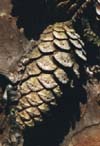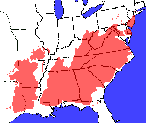
Cone and bark, mature specimen at Weymouth Woods State Park, NC [C.J. Earle, Mar-1999].
Common Names
Shortleaf pine, shortstraw pine, southern yellow pine.Taxonomic notes
Description
"Trees to 40 m; trunk to 1.2 m diam., straight; crown rounded to conic. Bark red-brown, scaly-plated, plates with evident resin pockets. Branches spreading-ascending; 2-year-old branchlets slender (ca. 5 mm or less), greenish brown to red-brown, often glaucous, aging red-brown to gray, roughened and cracking below leafy portion. Buds ovoid to cylindric, red-brown, 0.5-0.7(1) cm, resinous. Leaves 2(3) per fascicle, spreading-ascending, persistent 3-5 years, (5)7-11(13) cm x ca. 1 mm, straight, slightly twisted, gray- to yellow-green, all surfaces with fine stomatal lines, margins finely serrulate, apex abruptly acute; sheath 0.5-1(1.5) cm, base persistent. Pollen cones cylindric, 15-20 mm, yellow- to pale purple-green. Seed cones maturing in 2 years, semipersistent, solitary or clustered, spreading, symmetric, lanceoloid or narrowly ovoid before opening, ovoid-conic when open, 4-6(7) cm, red-brown, aging gray, nearly sessile or on stalks to 1cm, scales lacking contrasting dark border on adaxial surfaces distally; umbo central, with elongate to short, stout, sharp prickle. Seeds ellipsoid; body ca. 6 mm, gray to nearly black; wing 12-16 mm. 2 n =24" (2).Range
USA: New York, Pennsylvania, Ohio, Illinois, Arkansas, Missouri, Kentucky, Tennessee, West Virginia, Maryland, Delaware, Virginia, North Carolina, South Carolina, Georgia, Florida, Alabama, Mississippi, Louisiana, Oklahoma and Texas. Typically in uplands, relatively dry forests at 200 to 610 m elevation (2). See also (4).Big Tree
Diameter 108 cm, height 42 m, crown spread 23 m, located in Myrtle, MS ( American Forests 1996 ).Oldest
Dendrochronology
Ethnobotany
Highly valued for timber and pulpwood (2).Observations
Remarks
It hybridizes with P. taeda , its most common associate (2).Citations
(1) Elias, Thomas S. 1987. The complete trees of North America; a field guide and natural history. NY: Gramercy Publ. Co.(2) Robert Kral in Flora of North America online.
(3) Burns, R.M. and B.H. Honkala. 1990. Silvics of North America, Vol. 1, Conifers. Washington DC: U.S.D.A. Forest Service Agriculture Handbook 654. http://willow.ncfes.umn.edu/silvics_manual/Table_of_contents.htm .
(4) Robert S. Thompson, Katherine H. Anderson and Patrick J. Bartlein. 1999. Atlas of Relations Between Climatic Parameters and Distributions of Important Trees and Shrubs in North America. U.S. Geological Survey Professional Paper 1650 A&B. URL= http://greenwood.cr.usgs.gov/pub/ppapers/p1650-a/pages/conifers.html, accessed 22-Jan-2000.
See also:
Anantha M. Prasad and Louis R. Iverson. 1999. A Climate Change Atlas for 80 Forest Tree Species of the Eastern United States. http://www.fs.fed.us/ne/delaware/atlas/ . Delaware, Ohio: USFS Northeastern Research Station.
The FEIS database .
back | Pinus | Pinaceae | home
This page is from the Gymnosperm Database
URL: http://www.geocities.com/~earlecj/pi/pin/echinata.htm
Edited by Christopher J. Earle
E-mail:
earlecj@conifers.org
Last modified on 28-Jan-2000
